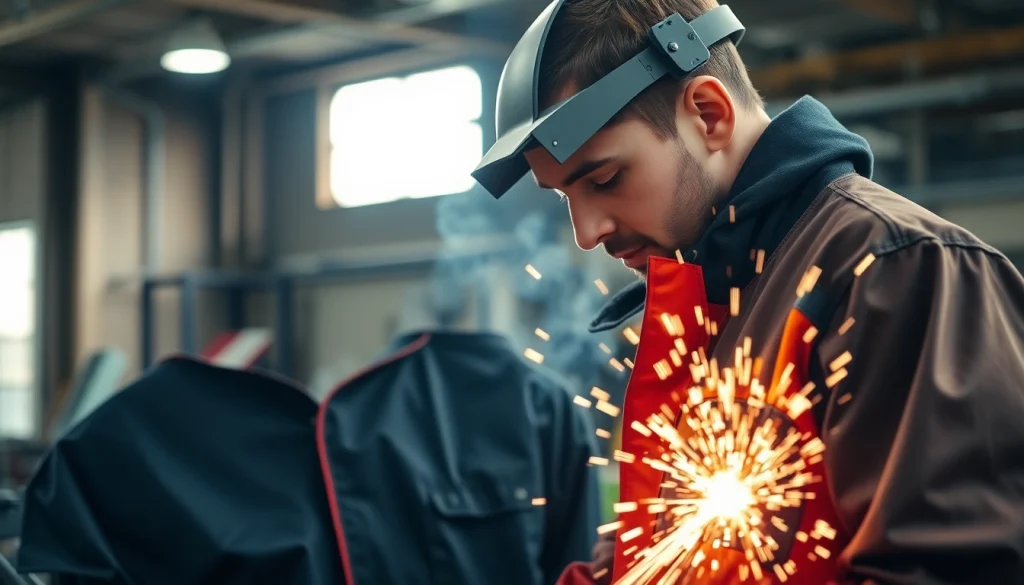Understanding Welding Jackets: What You Need to Know
Definition of Welding Jackets
A welding jacket is a specialized piece of protective clothing worn by welders and metalworkers during their tasks. Designed to shield users from intense heat, sparks, and spatter produced during welding processes, these jackets are critical components of personal protective equipment (PPE) in the welding industry. They not only offer protection but also function well in various working environments, providing comfort and durability required during welding activities. A welding jacket typically features high-quality flame-resistant materials to ensure safety and longevity.
Importance of Safety in Welding
The welding process, while essential in many industries such as construction and manufacturing, poses several hazards. These include exposure to molten metal, harmful fumes, and intense UV radiation. Wearing appropriate protective clothing, like welding jackets, minimizes the risk of burns, skin irritation, and respiratory problems related to welding gases. As such, investing in quality PPE is not merely a regulatory requirement but a fundamental aspect of worker safety and health in any welding operation.
Common Materials Used in Welding Jackets
Welding jackets are made from various materials, each offering different levels of protection and comfort. Common materials include:
- Leather: High durability and exceptional protection against extreme heat and spatter, leather jackets are ideal for heavy-duty welding. They can withstand abrasion and are often used in environments with high risk.
- Flame-Resistant Cotton: This is typically woven from flame-retardant treated cotton, which is lightweight and comfortable. It is suitable for light to moderate welding tasks.
- Composite Materials: Some modern jackets feature synthetic blends designed to resist flame and abrasion. These materials offer flexibility and breathability, making them suitable for varied working conditions.
Key Features of a Quality Welding Jacket
Flame Resistance Ratings Explained
When selecting a welding jacket, understanding its flame resistance rating is crucial. Generally, these ratings indicate how long a material can resist ignition and how quickly it extinguishes itself after the flame source is removed. Common standards include:
- NFPA 701: This standard tests the flammability of textiles for use in areas needing fire safety compliance. It is crucial for clothing worn during welding.
- ASTM F1506: This rating indicates compliance with specific electric arc protection standards, often essential for welders in electrical settings.
Welders should look for jackets that meet or exceed these ratings to ensure maximum safety.
Comfort and Fit Considerations
While safety is the primary function of a welding jacket, comfort and fit should not be overlooked. A well-fitting jacket allows for unrestricted movement, which is essential for the flexibility required while welding. Considerations include:
- Size: Ensure the jacket fits correctly — not too tight or restrictive to hinder movement.
- Weight: Lightweight jackets can reduce fatigue during long welding sessions, while heavier options provide more protection.
- Ventilation: Look for designs that include ventilation features, as these can significantly enhance comfort in hot or humid environments.
Durability and Maintenance Requirements
The durability of a welding jacket plays a significant role in its effectiveness and lifespan. High-quality jackets withstand frequent use and harsh conditions without losing protective qualities. Regular maintenance is essential to preserve fabric integrity and flame resistance. Washing instructions should follow manufacturer’s guidelines, typically recommending:
- Machine washing in cold water to prevent shrinkage.
- Avoiding bleaches or fabric softeners, as these can deteriorate flame-resistant properties.
- Proper drying methods, often air drying is preferred to maintain material structure.
Types of Welding Jackets Available
Leather vs. Fabric Welding Jackets
The choice between leather and fabric jackets largely depends on the specific needs of the welder:
- Leather Jackets: Known for their high level of protection against sparks and extreme heat, these jackets are perfect for fabrication work and heavy-duty tasks. However, they can be hot in warmer weather.
- Fabric Jackets: Generally lighter and more breathable, fabric options like flame-resistant cotton or synthetic blends provide versatility for various welding applications. They may not offer the same level of protection under extreme conditions, though.
Customizable Options for Welders
Many welding professionals choose customized jackets for enhanced fit and functionality. Custom options may include:
- Choice of materials based on specific needs.
- Personalized sizing for a better fit.
- Additional features such as pockets or tool loops.
Customizing your welding jacket can improve comfort and utility while promoting brand visibility if company logos are included.
Choosing the Right Type for Your Needs
Welders should consider factors such as the type of welding being performed (MIG, TIG, Stick), environmental conditions, and job duration when selecting a jacket. Consulting with experienced welders can provide insight into practical choices that balance protection, comfort, and style.
Care and Maintenance Tips for Welding Jackets
Washing and Storing Your Welding Jacket
Regular maintenance ensures the longevity of your welding jacket. Always read care labels for specific washing instructions. A general guideline includes:
- Use appropriate detergents designed for flame-resistant clothing.
- Store jackets away from direct sunlight and heat sources to prevent fabric degradation.
- After use, check for any damages like burns or frays, and repair immediately if possible.
Signs That It’s Time to Replace Your Jacket
Understanding when to replace your welding jacket can help maintain safety standards. Look for signs including:
- Visible wear or holes that can compromise safety.
- Loss of flame resistance, which may be inferred from the inability to pass standard tests.
- General deterioration of material, which affects comfort and effectiveness.
Enhancing Longevity Through Proper Care
In addition to regular cleaning, ensure that the jacket is adequately maintained to extend its lifespan. Consider treating the fabric with protective sprays to enhance resistance against moisture and dirt. Avoid exposing the jacket to harsh chemical substances that can damage fabric fibers.
Where to Buy Quality Welding Jackets
Top Brands and Retailers to Consider
Numerous reliable brands manufacture high-quality welding jackets. Some recommended brands include:
- Miller Electric: Known for durable materials and innovative designs.
- Lincoln Electric: Offers a variety of jackets tailored for different welding applications.
- Revco Black Stallion: Popular for stylish options without sacrificing safety.
Online Shopping vs. In-Store Purchases
Choosing between online and in-store purchases can depend on personal preference. Online shopping offers convenience and wider selections, while in-store options allow for handling and trying on jackets before purchasing. Consider both methods to gain the best fit and value.
Evaluating Price Versus Quality
Investing in a quality welding jacket is critical. While cheaper options may seem attractive, the safety and durability they provide are paramount. Assess jackets based on fabric quality, comfort, and brand reputation rather than focusing solely on price. Remember that a more expensive jacket might save you money in the long run by reducing replacement frequency and increasing safety.


